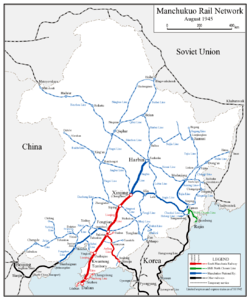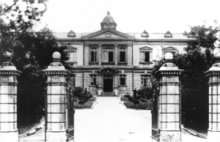South Manchuria Railway
 | |
Native name | 南満州鉄道 |
|---|---|
| Founded | 26 November 1906 |
| Headquarters |
Dairen, SMR Railway Zone, Xinjing, Manchukuo (after 1931) |



South Manchuria Railway (Chinese: 南滿鐵路; pinyin: Nánmǎn Tiělù), later also known as the Changda Railway (Chinese: 長大鐵路; pinyin: Cháng Dà Tiělù), is the historical name of the combined length of the Shenyang-Dalian Railway and the Shenyang—Changchun portion of the Beijing–Harbin Railway, roughly along the same corridor as the modern day Harbin–Dalian High-Speed Railway. It was built in 1898-1903 by Imperial Russia as the southern branch of the Chinese Eastern Railway, according to the 1896 secret treaty and the 1898 lease convention between Qing China and Russia in the aftermath of the First Sino-Japanese War. After the Russo-Japanese War, Imperial Japan seized control of all the length of the railway south of Changchun, and renamed it as the South Manchurian Railway.
The South Manchuria Railway Company (南満洲鉄道株式会社 Minami Manshū Tetsudō Kabushiki-gaisha), or Mantetsu (満鉄, literally "Manchurian Railway") for short, was a company founded by the Japanese in 1906 and operated within the Japanese-controlled South Manchuria Railway Zone. The Japanese-controlled railway ran from Lüshun Port at the southern tip of the Liaodong Peninsula to Changchun, where it connected to the Russian-controlled portion of the southern Chinese Eastern Railway. The company was often referred to as "Japan's East India Company in China".
History

Following the Japanese victory over Imperial Russia in the Russo-Japanese War and the signing of the Treaty of Portsmouth, most of the southern branch (Harbin—Port Arthur) of the China Eastern Railway was transferred to Japanese control. The last station remaining in Russian hands was at Kuanchengzi (寬城子) in modern-day Changchun. The northernmost Japanese-controlled station was the Changchun Railway Station.[1][2]
Under the authorization of Emperor Meiji, Japan then established a new semi-privately held company, the South Manchurian Railway Company (a.k.a. Mantetsu), with a capitalization of 200 million yen to operate the railroad and to develop settlements and industries along its route.[3] The organizing committee was headed by General Kodama Gentarō, and after his death, by General Terauchi Masatake. Count Gotō Shimpei, formerly the Japanese governor of Taiwan, was appointed the first president of the company, and the headquarters was established in Tokyo before relocated to Dalian in 1907.[4]
One of the first tasks of the new company was to change the railway gauge. The rail line was originally built according to the gauge of 5 ft (1,524 mm), during the war it had been converted by the advancing Japanese troops to the Japanese 3 ft 6 in (1,067 mm) gauge, in order to facilitate the use of rolling stock brought from Japan. But once the new Japanese South Manchuria Railway company took possession of the line, it had the tracks re-gauged again, now to the gauge of 4 ft 8 1⁄2 in (1,435 mm) standard gauge,[5] presumably with an eye to connecting the system to other railways of China.
In 1907, an agreement was reached between the Japanese and Russian authorities about connecting the Japanese South Manchuria Railway with the line to the north, which remained in the hands of Russian China Far East Railway. According to the agreement, Russian gauge tracks would continue from the "Russian" Kuanchengzi Station to the "Japanese" Changchun Station, and vice versa, tracks on the "gauge adapted by the South Manchuria Railway" (i.e., the standard gauge) would continue from the Changchun Station to the Kuancheng Station.[2]
By the end of 1907, the company employed 9,000 Japanese and 4,000 Chinese. By 1910, those numbers had increased to 35,000 and 25,000 respectively.[4] The railway used a significant amount of U.S.-made rails and signaling equipment, as well as some steam locomotives built by the American Locomotive Company at Dunkirk, NY. A visiting executive from the Erie Railroad was quite impressed with the arrangement, and described South Manchurian Railway ca. 1913 as "the only railroad in the whole world that is like our American railroads (and they are, fairly speaking, the best)".[5]


Mantetsu quickly expanded the system inherited from Russia to staggering proportions, building coal mines at Fushun and Yantai, and harbor facilities at Andong, Yingkou, and Dalian. At each station, Mantetsu built hotels for travelers and warehouses for goods. Japanese settlers were encouraged through the construction of schools, libraries, hospitals and public utilities. The Mantetsu Research Wing was the centerpiece of Japan's colonial program, and instigated agricultural research into development of soybean farming. Land under cultivation expanded 70% in 20 years.[6]
From 1916, Mantestu began to spin off a number of subsidiary companies, including Showa Steel Works, Dalian Ceramics, Dalian Oil & Fat, South Manchurian Glass, as well as flour mills, sugar mills, electrical power plants, shale oil plants and chemical plants.[7]
Until 1925, the company also operated the Korean railway system.
Company assets rose from 163 million yen in 1908 to over a billion yen in 1930. Mantetsu was by far the largest corporation in Japan, and also its most profitable, averaging rates of return from 25-45 percent per year.[6] During the 1920s, Mantetsu provided for over a quarter of the Japanese government's tax revenues.[8]
Over 75% of Mantetsu's income was generated by its freight business, with the key to profitability coming from soybean exports, both to Japan proper and to Europe. Soybean production increased exponentially with increasing demand for soy oil, and for soy meal for use in fertilizer and animal feed. By 1927, half of the world's supply of soybean was from Manchuria and the efforts by Mantetsu to expand production and to ship to export ports was a classic example of an extractive colonial economy dependent on a single product.[8]

Mantetsu was also charged with a government-like role in managing the rail transportation system after the formation of Manchukuo in 1932. By 1938, Mantetsu had 72 subsidiary companies, development projects in 25 urban areas and carried 17,515,000 passengers per year.[9] Between 1930-1940, the Japanese population of Manchukuo rose by 800,000 making ethnic Japanese the majority in many of the towns and cities served by Mantetsu. Mantetsu prided itself on state-of-the-art urban planning, with modern sewer systems, public parks, and creative modern architecture far in advance of what could be found in Japan itself. These things were possible due to Mantetsu's tremendous profitability, and its political power to seize property and silence opposition and dissent at will through its political connections to the military and totalitarian national leadership.[10]
In 1934, Mantetsu inaugurated the "Asia Express", a high speed train from Dalian to the Manchukuo capital of Hsinking (Changchun). Reaching a top speed of 134 km/h (83 mph), the "Asia Express" was the fastest scheduled train in Asia at the time.
Changchun remained the break of gauge point between the Russian and standard gauges in the 1930s,[11] until the Chinese Eastern Railway itself was bought by Manchukuo and converted to the standard gauge in the mid-1930s.
In 1945, the Soviet Union invaded and overran Manchukuo. Rolling stock and movable equipment was looted and taken back to the Soviet Union, some of which was returned when the Chinese Communist government came into power. Mantetsu itself was dissolved by order of the American occupation authorities in occupied Japan. The People's Republic of China government later merged the northern half of the South Manchurian Railway with the Jingshen Railway to form the present day Beijing-Harbin Railway.
Mantetsu presidents

| Name | From | To | |
|---|---|---|---|
| 1 | Shinpei Goto | 13 November 1906 | 14 July 1908 |
| 2 | Yoshikoto Nakamura | 19 December 1908 | 18 December 1913 |
| 3 | Ryutaro Nomura | 19 December 1913 | 15 July 1914 |
| 4 | Yujiro Nakamura | 15 July 1914 | 31 July 1917 |
| 5 | Shimbei Kunisawa | 31 July 1917 | 12 April 1919 |
| 6 | Ryutaro Nomura | 12 April 1919 | 31 May 1921 |
| 7 | Senkichiro Hayakawa | 31 May 1921 | 14 October 1922 |
| 8 | Takeji Kawamura | 24 October 1922 | 22 June 1924 |
| 9 | Banichiro Yasuhiro | 22 June 1924 | 19 July 1927 |
| 10 | Jōtaro Yamamoto | 19 July 1927 | 14 August 1929 |
| 11 | Mitsugu Sengoku | 14 August 1928 | 13 June 1931 |
| 12 | Yasuya Uchida | 13 June 1931 | 6 July 1932 |
| 13 | Hakutaro Hayashi | 26 July 1932 | 2 August 1935 |
| 14 | Yōsuke Matsuoka | 2 August 1935 | 24 March 1939 |
| 15 | Takuichi Ohmura | 24 March 1939 | 14 July 1943 |
| 16 | Naoto Kobiyama | 14 July 1943 | 11 April 1945 |
| 17 | Motoki Yamazaki | 5 May 1945 | 30 September 1945 |
See also
- Manchukuo National Railway
- Kwantung Leased Territory
- South Manchuria Railway Zone
- Yamato Hotels
- Harbin–Dalian High-Speed Railway, a new high-speed railway being constructed along a parallel route
References
- ↑ Changchun Ⅱ- Le chemin de fer de Changchun (in French)
- 1 2 "Provisional Convention ... concerning the junction of the Japanese and Russian Railways in Manchuria" - June 13, 1907. Endowment for International Peace (2009). Manchuria: Treaties and Agreements. BiblioBazaar, LLC. p. 108. ISBN 1-113-11167-4.
- ↑ Young, Japan's Total Empire, pp 25
- 1 2 Coox, Nomonhan pp.6
- 1 2 Luis Jackson, Industrial Commissioner of the Erie Railroad. "Rambles in Japan and China". In Railway and Locomotive Engineering, vol. 26 (March 1913), pp. 91-92
- 1 2 Coox, Nomonhan pp.21
- ↑ Young, Japan’s Total Empire, pp32
- 1 2 Young, Japan's Total Empire, pp 31-32
- ↑ Coox, Nomonhan, pp 1078
- ↑ Young, Japan’s Total Empire, pp.250
- ↑ Yesterday and To-day, The New Zealand Railways Magazine, Volume 6, Issue 8 (April 1, 1932.)
- Coox, Alvin (1990). Nomonhan: Japan Against Russia, 1939. Stanford University Press. ISBN 0-8047-1835-0.
- Young, Louise (1999). Japan's Total Empire: Manchuria and the Culture of Wartime Imperialism. University of California Press. ISBN 0-520-21934-1.
External links
| Wikimedia Commons has media related to South Manchuria Railway. |
